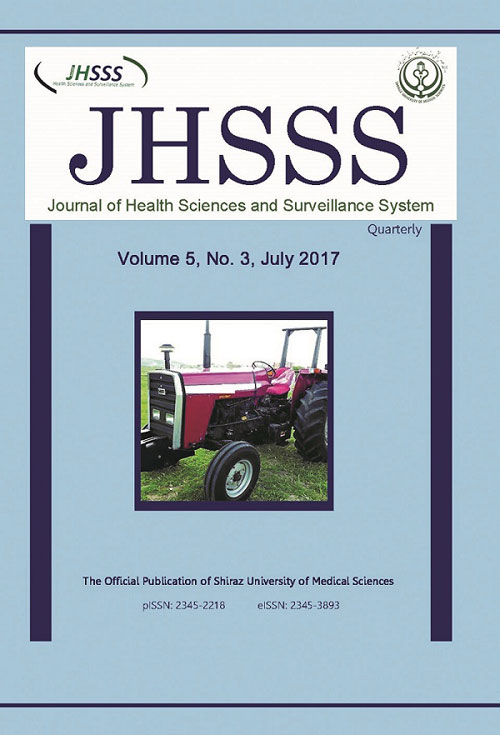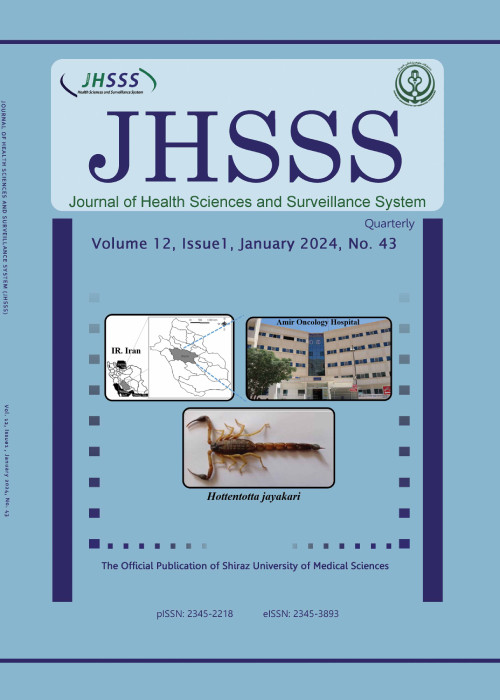فهرست مطالب

Journal of Health Sciences and Surveillance System
Volume:5 Issue: 3, Jul 2017
- تاریخ انتشار: 1396/05/07
- تعداد عناوین: 6
-
-
Pages 100-106BackgroundDue to the high cost of advanced tractors in developing countries, their use with lower cost and technology has been further considered. Consequently, many of these machines in terms of ergonomics are in poor condition and cause musculoskeletal problems in the drivers. This study aimed to identify harmful postures causing musculoskeletal disorders in the tractor drivers in Iran.MethodsThe study was conducted in March 2018 among farmers in Golestan province. The tasks of tractor drivers are divided into three stages consisting of getting on, steering tractor, and getting off. Rapid Entire Body Assessment (REBA) method was used to assess the body postures. In REBA, different postures of the body regions such as the neck, wrist, hands and legs were assessed and finally the level of risk was determined. Then, the levels of ergonomic interventions were suggested based on the risk level.ResultsBased on the REBA analysis, most of the tasks performed by the tractor drivers had medium risk and they need prompt investigation and change. For the task of getting on and getting off the tractor, the highest scores were assigned to the arms, legs and trunk. For the task of steering tractor, the highest postural scores were related to the wrists, trunk and legs.ConclusionErgonomic and posture conditions of Iranian tractors are not suitable. Therefore, it is necessary to implement ergonomic interventions to reduce the risk of developing musculoskeletal disorders.Keywords: Posture, Musculoskeletal Diseases, Farmers, Ergonomic Assessment
-
Pages 107-115BackgroundMonitoring the water quality and analyzing its changes over time is an important aspect of sustainable management and development of water resources. The purpose of the present study was to analyze the trend of temporal variations in the quality of drinking water supplied from groundwater sources in Shiraz, using IRWQI (Iran Water Quality Index) as well as statistical analysis.MethodologyThis study was conducted on groundwater resources in Shiraz, Iran from 2011 to 2015. 10 water quality parameters were used in this index including NO3, Fecal Coliform, EC, TH, SAR, BOD5, PO4, COD, pH, and DO, with their own weights. Repeated measure test was used in order to analyze the differences between IRWQI values between the study years.ResultsThe results showed that IRWQI varied between 89/96 (very good quality) and 49/51 (average quality) in the study years. The main causes of water quality decline were average to relatively high levels of hardness and nitrate. The general pattern of the changes in water quality has been accompanied by an increase and decrease, so that the water quality has improved from 2011 to 2013 but then declined until the end of the study.ConclusionRegarding the necessity of clarifying the water quality condition and its changes and the importance of using IRWQI as an emerging national indicator, water quality analysis in different parts of the country, taking advantage of this indicator and statistical analyses will help the country promote and accelerate the integrated management of water resources quality.Keywords: Water Quality, Groundwater, IRWQI, Drinking, Shiraz
-
Pages 116-122BackgroundDuring the last two decades, fertility has declined to replacement level in rural areas of Iran. The current study investigated the determinant factors of actual and ideal fertility, and fertility intention in rural women of Fars province.MethodThis is a cross-sectional study. The sample comprised 1301 rural married women aged 15 to 49 years in Fars province. Data were gathered in 2015 using structured questionnaires. Statistical analysis was run on STATA software, version 12.0. The semi-partial correlation was run to show the unique effect of each variable while controlling all the other variables. Finally, a multiple regression model was run with a significance level of 0.05.ResultsThe means(±SD) of actual and ideal fertility were 2.11±(1.32) and 2.81±(0.96), respectively, and for fertility intention it was 2.92±)1.00(. Age was the most determinant factor of actual, ideal fertility and fertility intention. The second effective factor was age at first birth. The determination coefficient for the actual fertility model showed that 62.1% of the variance in actual fertility was explained by age, age at first birth, woman’s education, and use of contraceptive methods. For ideal fertility and fertility intention, about 16.2% and 27.5% of the variance were explained by the independent variables, respectively.ConclusionAs a result of the rise in education and social position of younger women, the opportunity cost of having a child is more effective than ever. Therefore, fertility incentive policies could not be effective in increasing fertility, even in among rural population.Keywords: Fertility intention, Ideal fertility, Actual fertility, Rural-women
-
Pages 123-129BackgroundIn the present era, Digital Media Content has played an effective role in the formation of socio-economic and social behaviors. The aim of this research was to investigate the views of media experts in different levels of this filed on factors that affect user-media relationship in the following domains: non-verbal communication, interaction with media audience, effect of media on various domains, attitudes of the audience toward electronic media, and audience’s priorities- economic aspects in Iran.MethodsA questionnaire was designed and validated by a pilot study and distributed to a sample of 40 experts and users of digital media on July, 2017. The collected data was analyzed using SPSS Version 22; the significance level was set to 5% in hypotheses testing.ResultsThe results show that the participants generally agreed on all statements regarding the study domains. However, the level of agreement to all domains was different among different groups of the respondents (mean=14.03 among media strategists as the lowest and mean=35.13 among media managers as the highest levels of agreement, P<0.001) and the domains of the study (mean=28.50 for the higher impact of traditional media and mean=22.50 for the effect of communication technology on increase of interaction between media and audience).ConclusionThe highest rate of agreement was reported for the domain “Traditional media have a higher impact on their audience than the new media, suggesting the importance of traditional media in public knowledge and behavior. However, there was significant difference in the experts’ opinions regarding each domain.Keywords: Social Media, Health Literacy, Audience, Information Technology, Interactive Relationship
-
Pages 130-137During the last two centuries, human being has emitted huge amounts of greenhouse gases to the atmosphere, by providing energy from fossil fuels. The increasing accumulation of these gases in the atmosphere has led to "global warming" and as a result "climate change". This inauspicious phenomenon has such a wide domain that threat the survival of the human around the world. The sharp decline in fresh water sources and strategic agricultural products and severe destruction of environment are just some inevitable adverse effects of climate change. Therefore, it would be a proper ground for breaching some of the most important human rights. The aim of this research is to show effects of climate change on "right to health" and some other related rights, and therefore responsibilities of governments to fight against that.ConclusionClimate change due to human activities, makes a proper field for breach of human rights globally, and as we see "right to health" is affected absolutely. According to principal of "common but differentiated responsibilities", most of the burdens of combating against climate change are on the shoulders of developed states and developing countries have much less obligations; but at least have common responsibilities. Rather, all of the states have clear international obligations for protecting human rights in their territories. Therefore any state must separately or together with others, take urgent and also long term measures to fight this phenomenon. If climate change continues; negligence of states in performing due diligence in this regard may lead to their international responsibility or even their incapability for governing the state in accordance with "good governance principles".Keywords: Climate Change, Environment, Greenhouse Gases, Human Rights, Right to Health
-
Pages 138-143BackgroundIndividual factors play an important role in the safety performance of small and medium-sized enterprises that might have physical, mental or psychological nature. Some of these factors are related to the subjects’ personality and unchangeable; however, others are related to motivation and attitude, which could be improved through training. This study aimed to assess the safety attitude and its effective factors among workers in micro- and small-scale enterprises (MSSEs) in Shiraz in 2015.MethodsThis cross-sectional study was conducted on 349 workers in MSSEs. Safety Attitude Questionnaire (SAQ) was filled out by self-report method which consisted of questions including general information, cognitive, affective and conative dimensions. Then, SPSS software version 22 was used to assess the significant difference between the variables (p-value <0.05).ResultsThe mean score of safety attitude was (103.05±8.73 out of 125). The minimum and maximum safety attitude scores were related to affective (16.13±3 out of 20) and cognitive (46.7±4.12 out of 55) dimensions, respectively. Also, there was a significant difference between the educational level and safety attitude. Workers with higher education had higher safety attitude scores.ConclusionsThe results showed that most of the workers had safety attitude but they were not desirable in affective and conative domains. Therefore, it is required to enhance the affective domain through training the workers, enhancing their participation, paying attention to their views on occupational safety and health issues and promote the conative one through the supervision of legal authorities.Keywords: Safety attitude, Micro, Small-scale enterprises, Accidents


